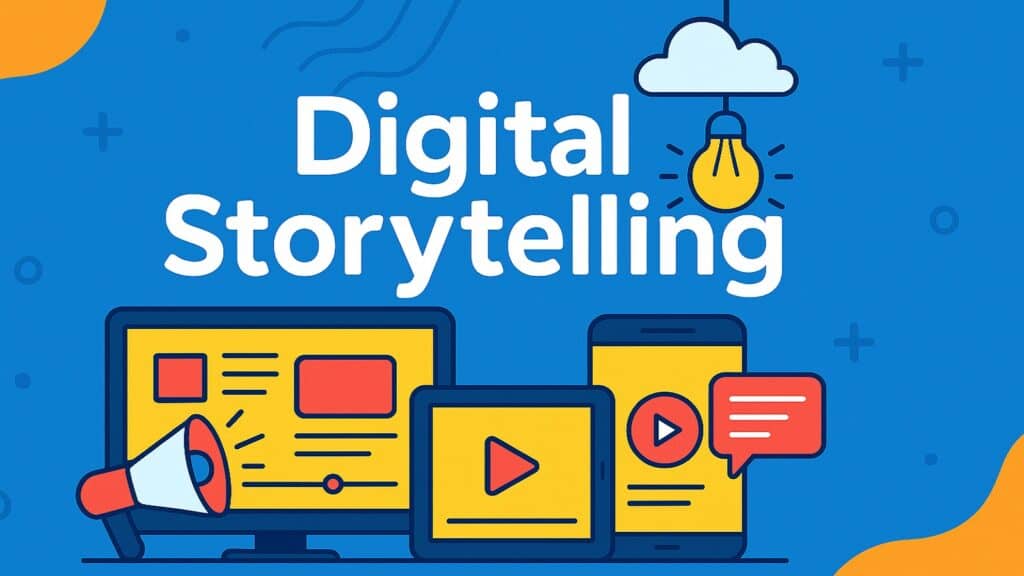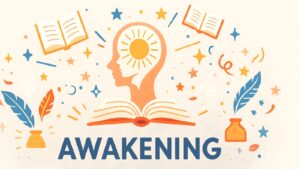Table of Contents
Introduction: Digital Storytelling — A New Lifeline for Cultural Memory
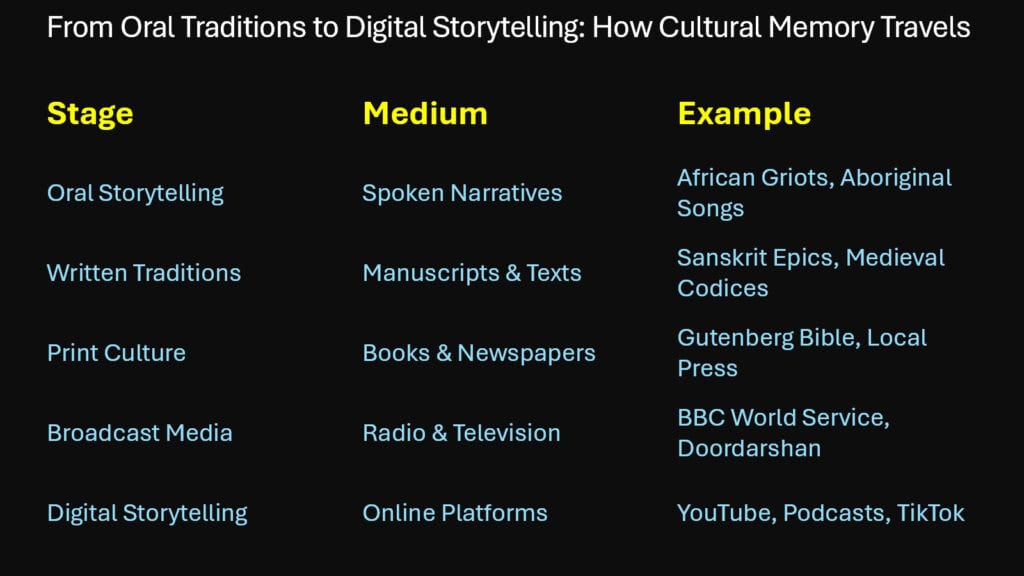
Memory has always been fragile. Empires crumble, languages fade, and traditions slip away like smoke in the wind. Yet something extraordinary happens when ancient stories meet modern screens. Digital storytelling has emerged as one of the most used and important storytelling formats of our time, breathing new life into cultural memories that might otherwise vanish forever.
Unlike the ephemeral nature of spoken word or the static quality of printed text, digital storytelling creates living archives. It captures the essence of oral traditions while expanding their reach beyond geographical boundaries. Where traditional storytelling formats like poetry, dramatic scripts, or graphic narratives might serve specific audiences or purposes, digital storytelling democratizes cultural preservation. A grandmother in rural Alaska can share her indigenous stories through YouTube videos, reaching descendants scattered across continents. A young artist in Mumbai can create Instagram reels that blend classical Indian dance with contemporary music, preserving ancient art forms while making them relevant to new generations.
The power lies in the medium’s versatility. Digital storytelling encompasses podcasts that echo ancient oral traditions, interactive documentaries that immerse viewers in historical contexts, and social media posts that document everyday cultural practices. This format transcends the limitations that once confined cultural transmission to specific communities or educated elites. It transforms culture from something preserved in museums into something lived and shared in real time.
The six ways digital storytelling preserves culture reveal a fascinating intersection of technology and tradition. From reviving oral storytelling practices through digital platforms to creating immersive virtual reality experiences, each approach offers unique advantages for cultural preservation. These methods range from simple voice recordings that capture disappearing dialects to complex augmented reality applications that let users walk through historical sites. Together, they form a comprehensive ecosystem of cultural memory that adapts to how people communicate today while honoring how they communicated throughout history.
Table 1: Digital Storytelling vs. Traditional Storytelling Formats
| Format | Primary Medium | Audience Reach | Interactive Elements | Preservation Method | Cultural Accessibility |
|---|---|---|---|---|---|
| Digital Storytelling | Multimedia platforms | Global/Unlimited | High interactivity | Cloud-based archives | Universal device access |
| Oral Storytelling | Spoken word | Local community | Live audience participation | Memory transmission | Limited to present audience |
| Poetry | Written/recited text | Literary circles | Interpretive only | Published collections | Requires literacy skills |
| Graphic Narratives | Visual-text combination | Visual learners | Static engagement | Physical/digital books | Visual literacy needed |
| Dramatic Scripts | Performance-based | Theatre audiences | Audience-performer dynamic | Script archives | Performance-dependent |
| Documentary Film | Video medium | Broadcast audiences | Passive viewing | Film archives | Equipment-dependent viewing |
1. Digital Storytelling and the Echo of Oral Traditions
The human voice carries something that written words cannot. It holds the tremor of emotion, the rhythm of breathing, the pauses that speak louder than sentences. Walter Ong understood this when he explored the fundamental differences between oral and literate cultures in his groundbreaking work on orality and literacy. His framework reveals how digital storytelling resurrects the communal essence of pre-literate societies while adapting to contemporary communication needs.
Digital platforms have become the new campfires around which communities gather. Ong’s theories, particularly those outlined in his seminal work “Orality and Literacy,” delve into the distinctions between oral and literate cultures, providing a comprehensive understanding of how communication methods shape human environments. YouTube monologues, podcast series, and voice-based social media posts mirror the participatory nature of ancient storytelling traditions. They create what Ong called “secondary orality” – a return to oral communication patterns through electronic media.
Consider how Indigenous communities across North America use digital storytelling to preserve their oral traditions. Elders record traditional stories on smartphones, uploading them to community websites where younger generations can access ancestral wisdom. These recordings maintain the vocal inflections, ceremonial timing, and cultural context that written transcriptions inevitably lose. The stories remain alive because they retain the human breath that gave them birth.
The transformation goes beyond mere recording. Digital storytelling platforms enable the audience participation that Ong identified as central to oral culture. Listeners leave comments, share their own versions of traditional stories, and engage in discussions that extend the original narrative. This interaction mirrors how oral traditions evolved through community retelling, with each generation adding layers of meaning while preserving core messages.
Voice-based platforms particularly excel at maintaining oral tradition characteristics. Podcast series dedicated to folklore, audio storytelling apps, and even voice messages on messaging platforms create intimate spaces where cultural knowledge transfers naturally. The medium strips away visual distractions, focusing attention on the storyteller’s voice and the story’s emotional resonance – exactly as oral traditions intended.
Table 2: Ong’s Orality Framework Applied to Digital Cultural Preservation
| Oral Culture Characteristic | Traditional Expression | Digital Storytelling Adaptation | Cultural Preservation Benefit |
|---|---|---|---|
| Participatory Experience | Community gathering storytelling | Interactive comment sections, live streaming | Maintains community engagement |
| Formulaic Expression | Repeated phrases, rhythmic patterns | Hashtags, memes, recurring formats | Preserves linguistic patterns |
| Situational Context | Stories tied to specific occasions | Platform-specific content, event-based posts | Maintains contextual relevance |
| Homeostatic Culture | Stories adapt to present needs | Content remixing, contemporary references | Ensures cultural evolution |
| Empathetic Communication | Personal, emotional connection | Voice messages, video diaries | Preserves emotional authenticity |
| Aggregative Structure | Additive rather than analytical | Thread-based storytelling, story chains | Maintains collective narrative building |
2. Digital Storytelling as a Bridge for Cultural Representation
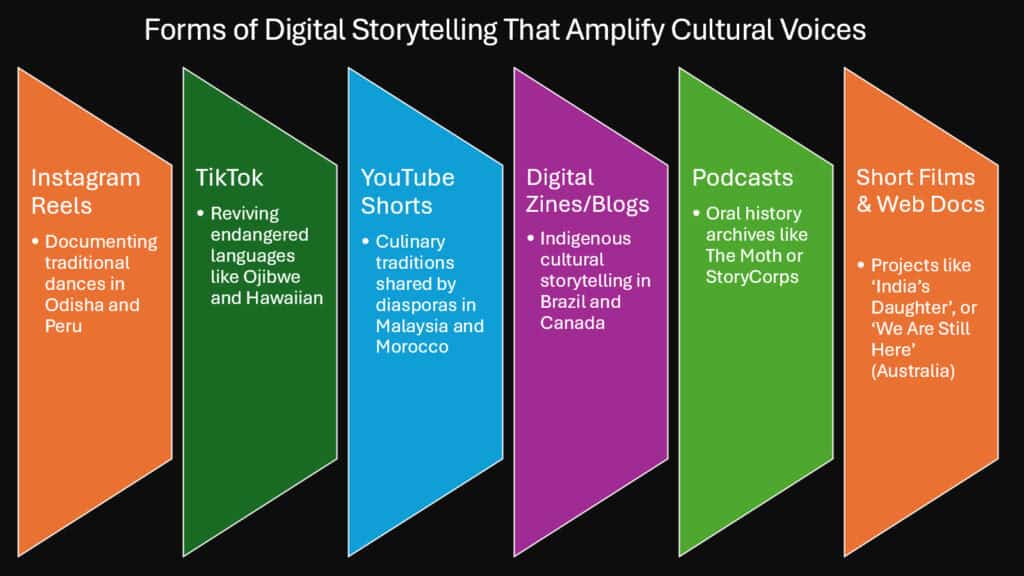
Representation matters because invisibility kills culture slowly. When communities cannot see themselves reflected in mainstream media, their stories begin to feel less important, their traditions less valid. Digital storytelling demolishes the gatekeepers who once determined which cultures deserved attention and which should remain hidden in academic footnotes.
Personal stories bring the past to life and help people relate to history on an emotional level by presenting individual experiences alongside historical events. Social media platforms have become stages where underrepresented communities perform their cultural identity for global audiences. Instagram reels showcase traditional cooking techniques passed down through generations. TikTok videos demonstrate regional dance forms that might otherwise survive only in rural villages. YouTube channels document disappearing crafts, from traditional pottery methods to indigenous textile weaving.
The democratization creates unprecedented opportunities for cultural self-representation. Communities no longer need permission from publishers, broadcasters, or cultural institutions to share their heritage. A single smartphone becomes a production studio capable of capturing high-quality documentation of cultural practices. Young people within communities become cultural ambassadors, translating traditional knowledge into digital formats their peers understand.
Language preservation exemplifies digital storytelling’s representational power. Minority languages often lack written literature or formal education programs, making them vulnerable to extinction. Digital platforms allow speakers to create content in their native tongues, building audiences that might span continents. Welsh speakers use social media to normalize their language in everyday contexts. Native American communities create children’s content that teaches traditional languages through engaging stories and songs.
The intimacy of digital storytelling particularly benefits cultures that emphasize personal relationships and family connections. Unlike formal documentaries or academic studies, social media content captures the casual moments where culture really lives – the grandmother teaching her granddaughter to braid her hair in traditional patterns, the father explaining the significance of family recipes while cooking together, the community elder sharing the meaning behind ceremonial practices.
Cultural celebrations gain new life through digital documentation. Festivals, religious ceremonies, and community gatherings become content that extends far beyond their original time and place. Diaspora communities use these digital artifacts to maintain connections with their ancestral practices, while curious outsiders gain authentic insights into traditions they might never encounter otherwise.
Table 3: Cultural Representation Through Digital Storytelling Platforms
| Platform Type | Content Format | Cultural Application | Community Benefit | Reach Potential |
|---|---|---|---|---|
| Short-form Video | 15-60 second clips | Traditional dance, cooking demos, craft tutorials | Quick cultural education | Viral sharing capability |
| Long-form Video | 10-60 minute documentaries | Ceremonial documentation, historical narratives | Comprehensive cultural context | Educational resource creation |
| Photo Storytelling | Image series with captions | Daily life documentation, festival coverage | Visual cultural preservation | Cross-language communication |
| Audio Narratives | Podcast-style storytelling | Oral history collection, language samples | Accessibility for elderly contributors | Intimate listening experience |
| Interactive Content | Polls, Q&A sessions, live streams | Cultural education, myth-busting | Real-time community engagement | Direct cultural exchange |
| Written Narratives | Blog posts, article series | Historical context, personal essays | Detailed cultural analysis | Academic accessibility |
3. Digital Storytelling and the Remix of Heritage
Tradition never stood still, though we sometimes pretend it did. Every generation inherits cultural practices and quietly reshapes them, adding contemporary relevance while maintaining essential meaning. Postmodernism recognizes this reality – culture exists in fragments, citations, and endless recombinations rather than pure, unchanging forms.
Digital storytelling embraces postmodern fragmentation as a feature rather than a flaw. Memes transform ancient symbols into contemporary commentary. Fan videos remix traditional folk songs with modern beats, creating hybrid forms that honor both past and present. TikTok users create content that references classical literature, historical events, and family traditions within the same fifteen-second clip, demonstrating how cultural knowledge operates through intertextual connections.
The remix culture that defines digital spaces reflects how tradition actually works. Folk tales survived centuries because storytellers adapted them for new audiences and changing circumstances. Digital storytelling simply accelerates this process while making it visible. Young creators sample audio from their grandparents’ stories, overlay it with contemporary visuals, and share the result with global audiences. The original narrative remains recognizable while gaining new layers of meaning.
Mashup culture specifically caters to diaspora communities that simultaneously navigate various cultural identities. Second-generation immigrants create content that blends their parents’ traditions with their current environment, producing authentic expressions of hybrid cultural identity. These works resist both total assimilation and rigid traditionalism, instead modeling how cultures naturally evolve through contact and exchange.
The nonlinear nature of digital storytelling aligns perfectly with postmodern sensibilities. Instagram story highlights allow users to create thematic collections that jump between time periods, geographic locations, and cultural contexts. Users might combine childhood photos from their homeland with current images from their adopted country, traditional recipes with modern variations, and ancestral languages with contemporary slang. The result feels authentic because it reflects how memory actually works – not as linear narrative but as associative fragments.
User-generated content demonstrates postmodern theory in action. Communities create collaborative timelines where multiple voices contribute perspectives on shared cultural experiences. Wikipedia-style platforms allow collective editing of cultural knowledge, ensuring that traditions remain alive through ongoing interpretation rather than fossilizing in authoritative versions.
Table 4: Postmodern Elements in Digital Cultural Storytelling
| Postmodern Concept | Traditional Cultural Expression | Digital Storytelling Application | Cultural Evolution Impact |
|---|---|---|---|
| Intertextuality | Oral references between stories | Hashtag connections, response videos | Creates cultural conversation networks |
| Fragmentation | Ritual components, seasonal celebrations | Story highlights, episodic content | Allows flexible cultural engagement |
| Pastiche | Ceremonial borrowing between cultures | Cross-cultural content mashups | Facilitates cultural fusion |
| Hyperreality | Idealized cultural memory | Filtered/enhanced cultural content | Shapes contemporary cultural identity |
| Deconstruction | Questioning traditional authority | Community-generated cultural content | Democratizes cultural interpretation |
| Metanarrative Rejection | Local vs. universal cultural stories | Platform-specific cultural expression | Validates diverse cultural perspectives |
4. Digital Storytelling as an Archive of the Everyday
Museums collect the extraordinary while everyday life vanishes without witness. The pottery sherds survive while the conversations over dinner disappear. Traditional archives preserve official documents and ceremonial objects but miss the mundane details that actually constitute lived culture. Digital storytelling inverts this hierarchy, making the ordinary precious.
Personal blogs, vlogs, and photo diaries create vast, crowdsourced cultural archives that capture what formal institutions overlook. A mother’s Facebook posts about her children’s language development document how multilingual families navigate identity. Food bloggers preserve not just recipes but the stories behind them – why certain dishes appear at specific celebrations, how cooking techniques vary between families, what ingredients substitute for traditional ones in new geographic contexts.
The archive of the everyday proves particularly valuable for understanding cultural adaptation and change. Social media posts reveal how immigrant communities modify traditional practices to fit new environments. Video diaries show how young people blend ancestral customs with contemporary lifestyles. Comment sections become repositories of cultural knowledge as community members share variations, corrections, and additional context.
Digital storytelling and technologies like virtual reality, 360-VR videos, and three-dimensional digitization enhance the preservation, communication, and appreciation of cultural heritage, with community engagement and affordable solutions being key factors. These everyday digital artifacts serve research purposes that traditional ethnographic methods struggle to achieve. They provide longitudinal data about cultural change, capture authentic rather than performed cultural behavior, and include voices that academic research often misses.
The cumulative effect creates cultural documentation of unprecedented scale and detail. Hashtag archives preserve language evolution in real time. Video platforms document regional accent variations that linguists previously required years to catalog. Photo sharing reveals how traditional clothing adapts to contemporary fashion sensibilities, how holiday celebrations incorporate new elements while maintaining core meanings.
Digital storytelling also preserves the emotional texture of cultural experience. Written ethnographies describe what people do but struggle to convey what practices feel like to participants. Video blogs capture the excitement of festival preparations, the solemnity of religious observances, the casual intimacy of family traditions. Voice messages preserve tonal qualities that indicate cultural meaning – the way respect modifies speech patterns, how humor functions differently across communities, what silence communicates in various contexts.
Table 5: Everyday Cultural Elements Preserved Through Digital Storytelling
| Cultural Element | Traditional Documentation | Digital Preservation Method | Archive Accessibility | Research Value |
|---|---|---|---|---|
| Daily Language Use | Academic linguistic studies | Social media posts, voice messages | Searchable, timestamped | Real-time language evolution |
| Food Practices | Cookbook recipes | Cooking videos, restaurant posts | Visual step-by-step guidance | Cultural adaptation tracking |
| Clothing Traditions | Museum collections | Fashion posts, celebration photos | Style evolution documentation | Contemporary cultural fusion |
| Family Rituals | Anthropological notes | Home videos, photo albums | Personal context preservation | Generational practice changes |
| Regional Celebrations | Official documentation | Live streaming, community posts | Participatory experience capture | Local variation understanding |
| Work Practices | Trade manuals | Tutorial videos, behind-scenes content | Skill transmission methods | Traditional knowledge preservation |
5. Digital Storytelling and Collective Identity Building
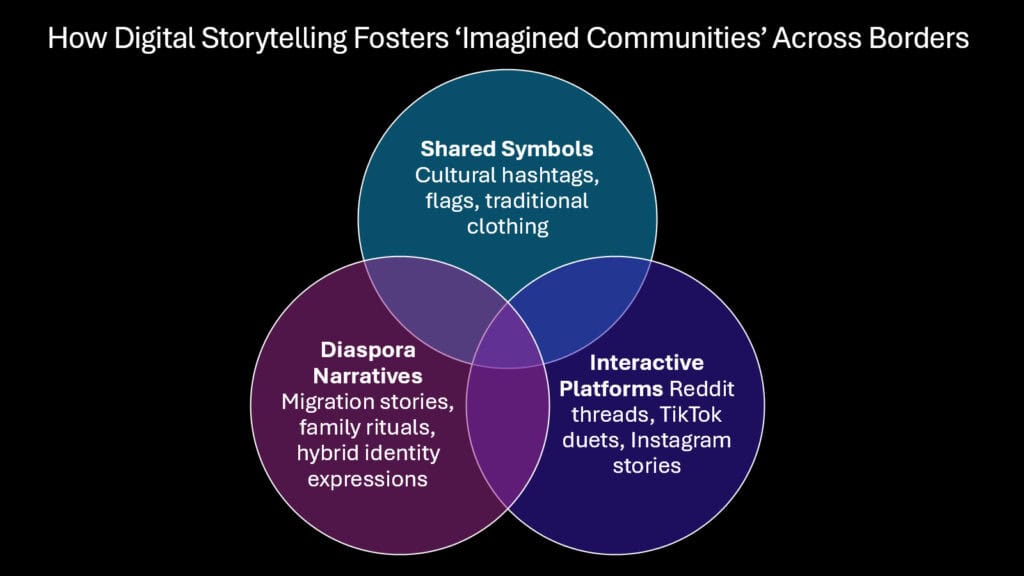
Benedict Anderson understood something profound about human community – people who never meet can still feel deeply connected through shared narratives. His concept of imagined communities explains how nations, ethnic groups, and cultural movements maintain cohesion across geographic distance and generational time. Digital storytelling amplifies this phenomenon, creating virtual spaces where dispersed individuals recognize themselves as part of collective cultural identity.
Hashtags operate similarly to Anderson’s concept of print capitalism, disseminating common symbols that foster a sense of community awareness. When diaspora members use tags like #FilipinoPride or #IrishHeritage, they participate in collective storytelling that reinforces group belonging. These digital practices mirror how newspapers once created national consciousness by providing shared reference points for geographically separated readers.
Collaborative storytelling threads demonstrate imagined community formation in real time. Users contribute individual experiences to collective narratives about shared cultural background. One person posts about their grandmother’s immigration story, another adds similar family history, and gradually a community narrative emerges that helps participants understand their individual experiences as part of larger historical patterns.
The participatory nature of digital platforms strengthens community bonds that physical distance might otherwise weaken. Multi-generational families scattered across continents maintain cultural connections through shared social media groups where they exchange stories, photos, and advice. These digital spaces become virtual homelands where cultural knowledge transfers between generations and geographic regions.
Cultural movements particularly benefit from digital storytelling’s community-building capacity. Social movements use shared narratives to create solidarity among participants who might never meet physically. Environmental activists share stories that create collective identity around protecting traditional lands. Indigenous rights advocates use digital storytelling to build international networks of support and cultural exchange.
The asynchronous nature of digital communication accommodates different community members’ schedules and time zones while maintaining continuous cultural conversation. Stories posted at one moment generate responses across multiple time periods, creating layered discussions that evolve community understanding over time. This temporal flexibility allows more inclusive participation than synchronous gatherings that might exclude members due to work schedules, health limitations, or geographic constraints.
Table 6: Anderson’s Imagined Communities Framework in Digital Cultural Spaces
| Community Element | Anderson’s Original Concept | Digital Storytelling Adaptation | Cultural Identity Impact |
|---|---|---|---|
| Shared Simultaneity | Newspapers read at same time | Trending hashtags, live events | Creates temporal community bonds |
| Horizontal Comradeship | Equal membership feeling | User-generated content equality | Democratizes cultural participation |
| Limited Boundaries | Clear in-group/out-group | Platform-specific communities | Maintains cultural distinctiveness |
| Sovereign Imagination | Community self-determination | Community-moderated spaces | Enables cultural self-governance |
| Print Language | Standardized communication | Platform vernaculars, shared memes | Develops digital cultural languages |
| Temporal Continuity | Historical narrative connection | Archive accessibility, story building | Links past and present community |
6. Digital Storytelling Through Immersive Technology
Experience teaches what explanation cannot. Reading about traditional pottery techniques differs fundamentally from watching clay transform under skilled hands, which differs again from virtually manipulating clay yourself through augmented reality. Immersive technologies transform cultural preservation from passive consumption into active engagement, letting users step inside their heritage rather than merely observing it from outside.
Virtual reality, 360-VR videos, and three-dimensional digitization enhance the preservation, communication, and appreciation of cultural heritage by creating experiences that engage multiple senses simultaneously. VR heritage sites allow users to walk through reconstructed historical environments, experiencing spatial relationships and architectural details that photographs cannot convey. Users can attend virtual ceremonies, explore traditional dwellings, and observe cultural practices from perspectives impossible in real-world settings.
Augmented reality applications overlay digital cultural information onto physical environments, creating hybrid spaces where past and present intersect. Users pointing smartphones at historical sites might see ghostly reconstructions of ancient buildings, hear audio narratives from long-dead inhabitants, or access multimedia presentations that contextualize current landscapes within cultural memory. These applications make cultural heritage visible in everyday spaces, transforming neighborhoods into interactive cultural museums.
Interactive documentaries signify a new frontier in the realm of immersive cultural storytelling. Unlike traditional documentaries that present fixed narratives, interactive formats allow users to choose their path through cultural content, exploring different aspects of traditions according to their interests and backgrounds. Users might follow a traditional craftsperson’s daily routine, explore various regional variations of cultural practices, or dive deep into historical contexts that explain contemporary traditions.
Gaming platforms increasingly serve cultural preservation purposes through immersive storytelling experiences. Indigenous communities collaborate with game developers to create virtual worlds where traditional stories unfold through interactive gameplay. Players learn cultural values not through direct instruction but through decision-making scenarios that demonstrate how traditional wisdom applies to contemporary challenges.
The sensory richness of immersive technologies particularly benefits cultural practices that depend on embodied knowledge. Traditional dance instruction through VR can capture subtle body movements that video demonstrations miss. Virtual cooking experiences can simulate the tactile feedback essential to understanding traditional food preparation. These technologies preserve cultural knowledge that exists in the body as much as the mind.
Table 7: Immersive Technology Applications in Cultural Preservation
| Technology Type | Cultural Application | User Experience | Preservation Benefit | Accessibility Feature |
|---|---|---|---|---|
| Virtual Reality | Historical site reconstruction | First-person exploration | Spatial context preservation | Location-independent access |
| Augmented Reality | Cultural site enhancement | Real-world overlay information | Contextual interpretation | Mobile device compatibility |
| Interactive Documentary | Traditional practice exploration | Choose-your-path learning | Multiple perspective preservation | Self-directed cultural education |
| Cultural Gaming | Traditional story gameplay | Immersive narrative participation | Values transmission through experience | Engaging younger audiences |
| 360-degree Video | Ceremonial documentation | Immersive observation | Complete environmental capture | Shared virtual presence |
| Haptic Technology | Traditional craft simulation | Touch-based learning | Embodied knowledge preservation | Multi-sensory cultural engagement |
Conclusion: Digital Storytelling — Culture’s Continuity in a Disrupted World
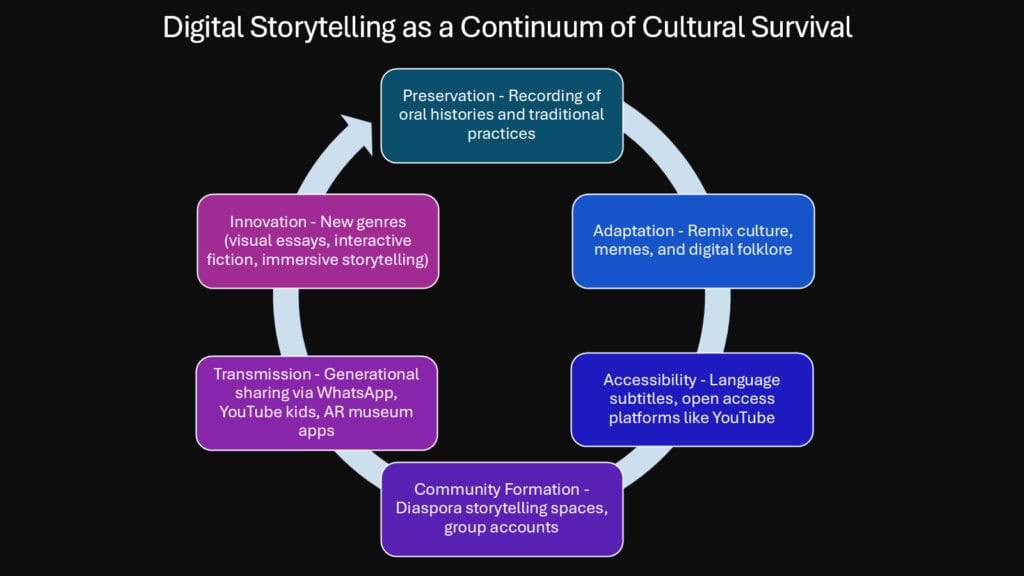
Stories outlive the civilizations that birth them. Epic poems survive fallen empires, folk tales cross oceans with migrating peoples, and sacred narratives adapt to new languages while preserving ancient wisdom. Digital storytelling continues this eternal pattern while expanding possibilities beyond what any previous generation could imagine.
The six ways digital storytelling preserves culture reveal both continuity and transformation in human cultural transmission. From oral traditions finding new voice through digital platforms to immersive technologies creating unprecedented cultural experiences, each approach honors what came before while embracing what comes next. Traditional storytelling formats served their communities well within their limitations, but digital storytelling transcends those constraints without abandoning the essential human need for narrative connection.
Digital storytelling plays a crucial role in preserving and sharing cultural heritage by enhancing engagement, promoting community involvement, and providing innovative dissemination frameworks for cultural institutions. The evidence suggests that digital storytelling do not replace traditional cultural preservation methods but rather amplify their reach and impact. A grandmother’s recorded stories become accessible to grandchildren she may never meet physically. A community’s festival documentation educates global audiences while reinforcing local cultural pride.
The democratization of cultural storytelling may prove as significant as the invention of writing or printing. For most of human history, cultural preservation required specialized knowledge, expensive technology, or institutional support. Digital storytelling places powerful preservation tools in ordinary people’s hands, allowing every community member to become a cultural archivist, every family to maintain its narrative tradition, every individual to contribute to collective cultural memory.
Yet technology alone cannot preserve culture – only human intention and care can accomplish that essential work. Digital storytelling succeeds when it serves genuine cultural needs rather than merely showcasing technological capabilities. The most effective digital cultural preservation happens when communities control their own narrative processes, when technology amplifies rather than replaces human connection, when innovation honors tradition while embracing change.
The future of cultural preservation lies not in choosing between traditional and digital methods but in thoughtfully combining their strengths. Digital storytelling presents unique opportunities for preserving cultural continuity; however, it necessitates a deliberate effort to guarantee that efficiency does not supplant authenticity, that global outreach does not diminish local significance, and that technological advancement does not eclipse human insight.
Table 8: Digital Storytelling’s Cultural Preservation Impact
| Preservation Aspect | Traditional Method Limitations | Digital Storytelling Solutions | Future Cultural Benefit |
|---|---|---|---|
| Geographic Reach | Local community boundaries | Global platform accessibility | Worldwide cultural connection |
| Generational Transfer | Physical presence requirements | Asynchronous content access | Flexible cultural learning |
| Language Preservation | Limited documentation methods | Multimedia language capture | Dynamic linguistic archives |
| Community Participation | Hierarchical cultural authority | Democratic content creation | Inclusive cultural ownership |
| Cultural Evolution | Slow adaptation processes | Real-time cultural documentation | Authentic change tracking |
| Resource Requirements | Institutional support dependence | Individual creation capability | Sustainable cultural preservation |

